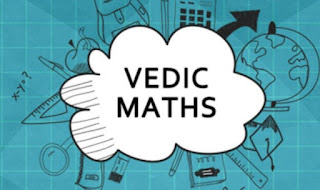VEDIC MATHS
By OMKAR TENDOLKAR
Hello friends,
This is post number 33 from the series of "Vedic maths" blogs. Here in this blog we will learn about "Example of Base method of multiplication when the number of digits in RHS exceeds number of zeros in the Base".
The base method of multiplication is having large contribution in Vedic Mathematics. The name Base method is given by Vedic Mathematics in western countries.
Actual Sanskrit sutra as given by Swamiji to define this system is:
‘Nikhilam Navatascaramam Dasatah.’ It means ‘all from 9 and the last from 10.’
For all practical purposes, we shall be calling the system elaborated in this chapter as the 'Nikhilam method' or simply the ‘Base Method'.
This method is used to multiply numbers. It is helpful in many cases where traditional multiplication takes a long time to calculate the answer. Let us take the case of multiplying the number 9999999 by 9999991.
If you go by the traditional method it will take a long time to multiply the numbers and calculate the product. However with the technique described in the Base Method one can find the answer in less than 5 seconds. The study of the Base Method is important to understand the other formulae of Vedic Mathematics.
There is a corollary of the Base Method which is called the Yavadunam Rule. This sutra is used in squaring numbers that we will discussed in the next post of our blogs.
Reference:
We had already learn about "Concept relating to Base" our previous blog. If you have missed my last blog then please visit "VEDIC MATHS-31".
We had already learn about "Base method of multiplication" our previous blog. If you have missed my last blog then please visit "VEDIC MATHS-32".
We have studied the four steps used in the base method of multiplication. Step 2 says that the RHS should be filled by as many digits as the number of zeros in the base. In some cases, the answer on the RHS was small and so we filled the remaining places by inserting zeros. An opposite situation may also arise when the number of digits on the RHS is more than the number of zeros in the base. In that case, we will have to carry over as we do in normal multiplication. Have a look at the following examples:
Examples:
1. Multiply 950 by 950
9 5 0
* 9 5 0
------------
STEP1: Find the Base and the Difference
Here in this example, both the number are closer to 1000 and we know that as a base we can take only power of 10's thus we will take 1000 as a base.
In this example, the difference between 1000 and 950 is 50.
After completing step 1, the question look as given below:
1000
9 5 0 - 5 0
* 9 5 0 - 5 0
----------------------
STEP 2: Number of digit on the RHS = Number of zeroes in the base
In the example, base 1000 has three zeros. Hence, the RHS will be filled in by three-digit number.
1000
9 5 0 - 5 0
* 9 5 0 - 5 0
----------------------
| _ _ _
STEP 3: Multiply the difference on The RHS
In this example, we multiply the difference , viz.. -50 by -50 and get the answer as 2500. Note that the RHS can be filled by a three-digit answer only but we have a four-digit number, namely 2500. We carry over the extra digit 2 to the LHS in next step.
1000
9 5 0 - 5 0
* 9 5 0 - 5 0
----------------------
| 5 0 0
STEP 4: Put the cross answer in the LHS
In given example, the cross answer can be obtained by doing (950 - 50). in either case the answer will be 950. This 950 we will put on the LHS. We carry over extra digit2 to LHS and add it to the number 900 and make it 902. But we already had 500 on the RHS.
Thus out multiplication process is complete.
1000
9 5 0 - 5 0
* 9 5 0 - 5 0
----------------------
9 0 2 | 5 0 0
Hence complete answer is 902500.
3. Multiply 150 by 140
100
1 5 0 + 5 0
* 1 4 0 + 4 0
----------------------
2 1 0 | 0 0
The base is 100 and the difference is 50 and 40 respectively.
The number of digits on the RHS will be 2 Vertical multiplication is 2000, a four-digit number But the RHS can only be filled in with two digits.
We carry over the two excess digits 20 to the LHS and add it to 190.The answer is 210. The LHS is 210 and the RHS is 00.
The final answer is 21000.
Examples:
Find multiplication of following:
- 112*100=11200
- 1300*1020=1326000
- 9200*9200=8464000
The simplicity of this method can be vouched from examples given above.
You may try following example:
Find Multiplication of followings
1. 1200 * 1020
2. 1230 * 1003
3. 10200 * 10500
You may answer this in comment box. You may ask your any query or doubt in comment box. I will try to resolve as early as possible.
In next blog we will discuss about "Example of Base method of multiplication Multiplying a number above the base with a number below the base".
Are you excited for this?...
Then, please wait for it.
I will post my new blog in next week.
We will meet very soon through our next blog. Till that stay connected, stay healthy and stay safe.
Thanks
for giving your valuable time.
Good day😊.


Comments
Post a Comment